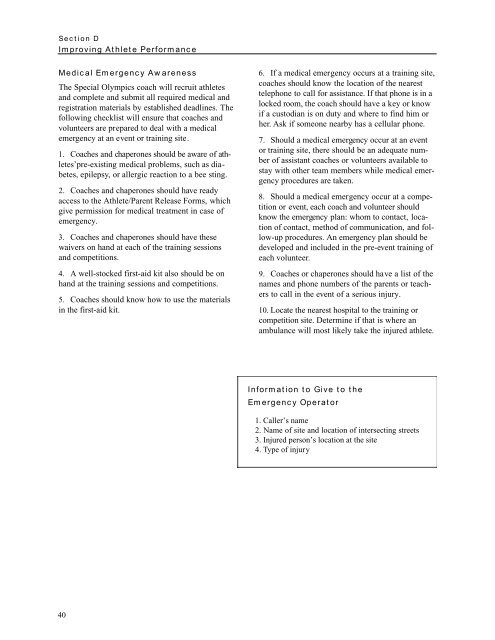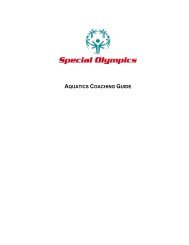Powerlifting Coaching Guide - Special Olympics
Powerlifting Coaching Guide - Special Olympics
Powerlifting Coaching Guide - Special Olympics
Create successful ePaper yourself
Turn your PDF publications into a flip-book with our unique Google optimized e-Paper software.
Section D<br />
Improving Athlete Performance<br />
Medical Emergency Awareness<br />
The <strong>Special</strong> <strong>Olympics</strong> coach will recruit athletes<br />
and complete and submit all required medical and<br />
registration materials by established deadlines. The<br />
following checklist will ensure that coaches and<br />
volunteers are prepared to deal with a medical<br />
emergency at an event or training site.<br />
1 . C o a ches and ch ap e rones should be awa re of at hl<br />
e t e s ’p re - ex i s t i n gmedical problems, such as diabetes,<br />
epilepsy, or allergic reaction to a bee sting.<br />
2. Coaches and chaperones should have ready<br />
access to the Athlete/Parent Release Forms, which<br />
give permission for medical treatment in case of<br />
emergency.<br />
3 . Coaches and chaperones should have these<br />
waivers on hand at each of the training sessions<br />
and competitions.<br />
4 . A well-stocked first-aid kit also should be on<br />
hand at the training sessions and competitions.<br />
5. Coaches should know how to use the materials<br />
in the first-aid kit.<br />
40<br />
6. If a medical emergency occurs at a training site,<br />
coaches should know the location of the nearest<br />
telephone to call for assistance. If that phone is in a<br />
l o cked ro o m , the coach should have a key or know<br />
if a custodian is on duty and where to find him or<br />
her. Ask if someone nearby has a cellular phone.<br />
7 . Should a medical emerge n cy occur at an eve n t<br />
or tra i n i n g site, there should be an adequate number<br />
of assistant coaches or volunteers available to<br />
stay with other team members while medical emergency<br />
procedures are taken.<br />
8. Should a medical emergency occur at a competition<br />
or eve n t , e a ch coach and volunteer should<br />
k n ow the emerge n cy plan: whom to contact, location<br />
of contact, method of communication, and follow-up<br />
procedures. An emergency plan should be<br />
developed and included in the pre-event training of<br />
each volunteer.<br />
9. Coaches or chaperones should have a list of the<br />
names and phone numbers of the parents or teachers<br />
to call in the event of a serious injury.<br />
1 0 . L o c ate the nearest hospital to the training or<br />
competition site. Determine if that is where an<br />
ambulance will most likely take the injured athlete.<br />
Information to Give to the<br />
Emergency Operator<br />
1. Caller’s name<br />
2. Name of site and location of intersecting streets<br />
3. Injured person’s location at the site<br />
4. Type of injury

















